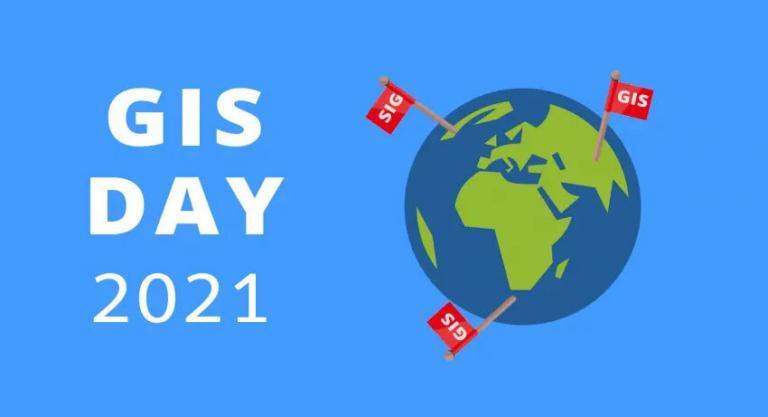
GIS Career Tips Anyone Can Benefit From
You’ve always loved geography.
And you’ve always loved technology.
This is why you’ve pursued a GIS career path.
But if you’re having trouble getting your foot in the door for a GIS job, we have a list of 10 GIS career tips that anyone can learn to do.
Let’s do this:
1. You’re More Than Just a “GIS Technician”
Nowadays, almost every industry is finding new ways to use GIS. Literally, there are thousands of GIS applications in use today. GIS is highly dispersed across sectors within the workforce. For example, government, environmental, and natural resources industries rely on GIS for decision-making. When you can learn GIS, you can advance your career in this growing technological sector.

But there are also the less obvious industries like healthcare, archaeology, and GIS on the farm. These industries are screaming for GIS. Make the business case for GIS at your organization.
Because you really are more than a GIS technician. You tilt the odds in your favor by having expertise in complementary fields like data science. If you master it by taking data science certification courses with GIS, you’d be next to unstoppable.
You can think of GIS as more of a tool to complement forestry, web development, geology, etc. A varied skill set serves you well. Adapt to technology and software change. Don’t ever stop training and don’t ever stop looking for a challenge. What are some of the other popular trending GIS jobs?
DATA SCIENCE: Data science has seen +650% job growth since 2012 (source: LinkedIn) and is estimated to grow by 11.5 million new jobs related to data science by 2026 (source: U.S. Bureau of Labor Statistics). These certificate courses in data science can help you get started in this emerging field.
PROGRAMMING: The U.S. Bureau of Labor Statistics (BLS) projects a 21% growth in employment for software developers from 2018 to 2028. Start learning software development with these GIS programming tutorials. But be careful about listing Python experience on your resume if you don’t want a programming job.
WEB MAP DEVELOPMENT: Web map development is a skill high in demand with JavaScript leading the way as the most popular programming language in web development. Get started with this FREE course on JavaScript to develop powerful modern web applications.
2. Rewrite Your CV/Resume
Most GIS applicants follow 3 steps when applying for a GIS job:
- First, they write their experience and skills in their resume.
- Second, they find a GIS job posting.
- Finally, they send that same resume to the employer and pray for a callback.
But this strategy will only get you screened out because you’re missing the key qualifications. In order to get an interview, you have to tailor your resume (CV) to job postings. For GIS analysts, programmers, cartographer jobs, and any career, this is how to stand out from the crowd.
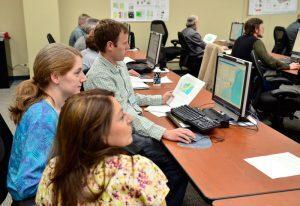
Here’s what you can do:
- After thoroughly reading a GIS job posting, highlight the required and desired qualifications.
- Next, list your relevant education, volunteer and work experience, and skills YOU bring to the company.
- Finally, rewrite your CV using the job description as a template and by matching your skills.
If something is important enough to be listed as a desired qualification, it is important enough to include it in your resume. If you rewrite your resume using the job posting as a template, you significantly stack the deck in your favor.
On average, 20% of job applicants get an interview. But this also means that 80% are left empty-handed for a GIS job interview. Don’t get screened out by thoroughly matching your skills to the job qualifications.
3. Explore Every Opportunity
You will most likely start your GIS career in an entry-level position. To be clear, GIS entry-level jobs are part-time often targeted at recent graduates, and do not include employee benefits.
On the other hand, GIS internships are opportunities offered to potential employees to work for a fixed or limited period of time. These GIS jobs give you mind-numbingly boring tasks. Also, they aren’t good at paying the bills.
But when it’s all said and done, you really just need the opportunity to get your foot in the door. Regardless of your experience, you can test out different opportunities without commitment.
When you’re first starting, apply for everything because getting a GIS job is not easy. But what should you do if there aren’t any GIS entry-level jobs or GIS internships available?
There is a tremendous amount of GIS volunteer opportunities available. Although GIS volunteers freely offer their services, they get something valuable in return. Of course, this is an on-the-job work experience.
For example, here are two popular GIS volunteering organizations:
- GIS CORPS: GIS Corps is one way how to tap into GIS volunteering. These volunteering opportunities could be anything from community development to improving health and education for underprivileged communities worldwide.
- URISA: Urban and Regional Information Systems Association (URISA) coordinates short-term, volunteer GIS services to humanitarian relief. Not only are you doing something good for the community, but you are also beefing up your GIS resume. All things considered, it’s a win-win situation for you.
In terms of GIS job trends, GIS developers and managers account for the highest percentage of job postings (Indeed, 2018). But in terms of job duties, GIS technicians, specialists, and analysts are similar. If you summed up their number of job postings, it would be close to the level of managers and developers.
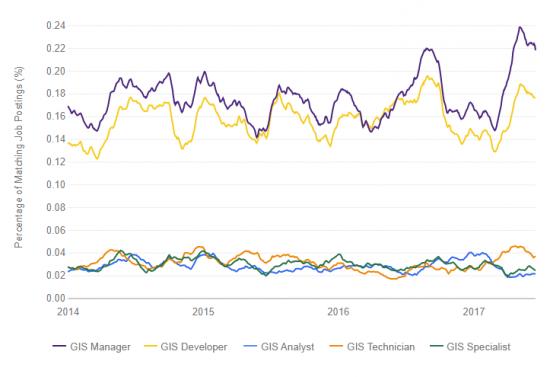
4. Plan Your Career in GIS When You’re in School
It’s never too early to plan for your future GIS career. If you think, live, and breathe GIS, integrate GIS into class projects. This is how to build experience for your future in GIS. Nothing makes a candidate stand out more than having a portfolio of work.
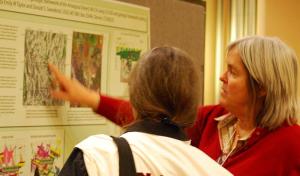
Pad your resume with these skills. Of course, this doesn’t mean you should lie. But it shows you’re eager to learn GIS on your own because employers want to see that.
While you’re at it, create a portfolio of maps. Highlight the best-looking maps and projects for interviews. Be prepared to talk about them. Not only does this show your mapping capability, but it also shows that you’re organized and can work independently.
Do you have a working website for your mapping portfolio? Even better. According to Workfolio, 56% of hiring managers are more impressed by a candidate’s personal website than any other personal branding tool. But only 7% of job seekers actually have a personal website. This is why GIS job seekers should have their own personal portfolio to be distinct and ultimately stand out.
5. Practice Makes Perfect Before the Interview
If you’re rusty in GIS, study up before the interview. Even if you’re not rusty, expect the unexpected for technical questions.
Interviewers will hammer you with technical questions on projections, tools, and databases. Don’t get caught off guard. It’s best to prepare yourself for an onslaught of GIS questions and do some interview prep beforehand.
When you land your dream GIS job, things don’t get much easier. You have to understand GIS inside-out because it’s about thinking critically and solving problems.
At your GIS job, you constantly deconstruct problems and solve them. There’s more than a single way to solve a problem. And more than likely others have solved the problem already.
In your GIS career, Google is your friend. If you hit a roadblock, see how others approach the same problem. Showing you have personal initiative and drive to problem-solve speaks miles.
PRO TIP: Keep up with GIS programming and scripting, specifically Python. This one skill is high in demand and can help you get a GIS job much faster.
6. Be Honest About Your Expected Salary
Here’s a scenario you may be familiar with: You apply for a GIS job you want. Then, you land an interview. But they hit you with the unexpected: “What are your salary expectations for this GIS job?”
Employers ask this question because they can filter candidates with too high expectations. Two unwanted things can happen when you give your GIS job salary expectation:
1. If you answer too high, you can cut yourself from the competition.
2. If you answer too low and undervalue your work potential, you might leave money on the table for the GIS job.
But the best thing is to be honest about your expected salary. So, how do you answer the GIS salary question during interviews? Here are some options to not get tongue-tied:
- Don’t get caught off-guard. Prepare your salary expectation beforehand
- Don’t list a salary range, if you’d be unhappy taking the lowest end of it.
- Research comparable GIS salaries. The labor market sets the price.
We’ve also scoped out the GIS job salary ranges for analysts, developers, and technicians. Overall, GIS jobs pay anywhere from $40,000 (GIS technicians) to over $100,000 (software engineers). Climb the GIS career ladder and move up the pay scale.
According to the US Bureau of Labor Statistics (BLS), geographers earn an average of $85,430 annually with a 1% job growth outlook. But cartographers and photogrammetrists earn an average of $68,380 per year with a job outlook to grow 5% from 2020 to 2030. This is much faster than the average rate of growth.
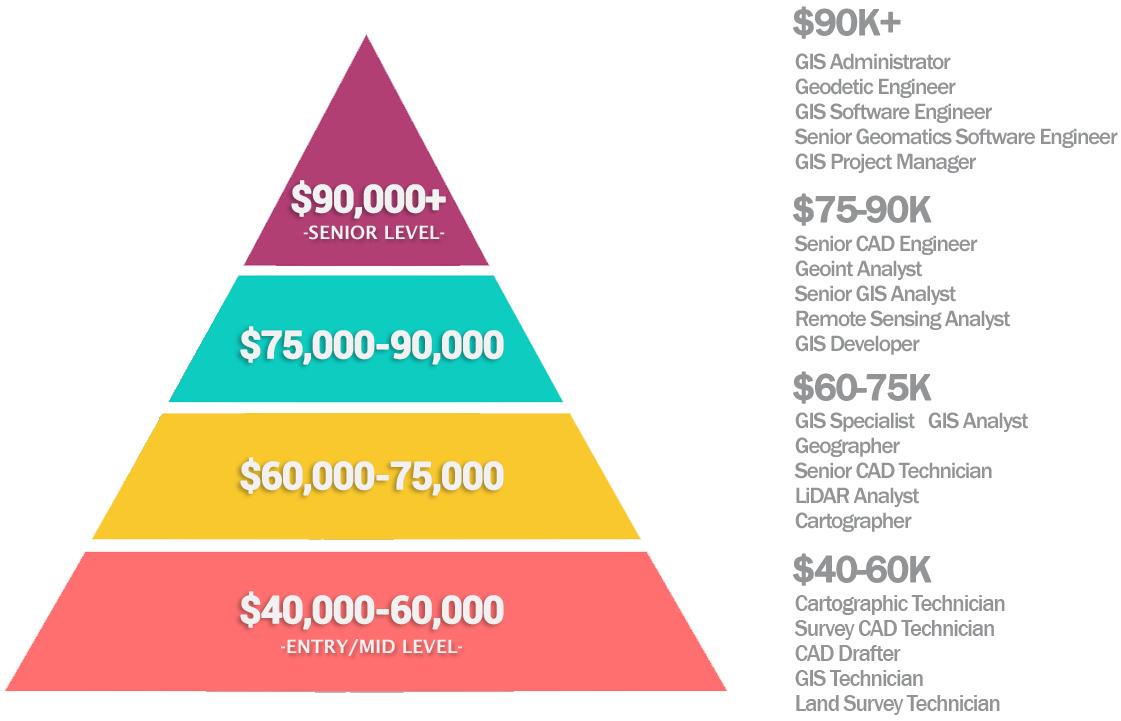
7. Join Your Local GIS User Group
User groups are the lifeblood of any GIS community. For whatever reason, GIS user groups are usually very active. They’re YOUR community and YOUR chance to really build relationships with your peers.
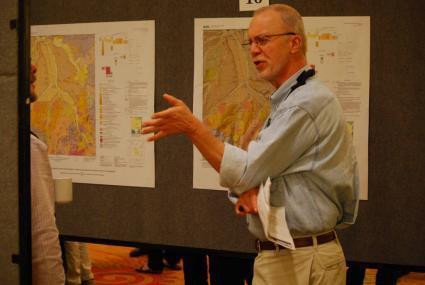
According to the Federal Reserve Bank of New York, personal referrals from friends who work for employers with job openings are the #1 way to get hired today.
This means that as bad as it sounds: It’s not what you know, it’s who you know. So, the question is, how can you rub shoulders with GIS influencers near you?
One tip is to join your state, provincial, or local GIS user group. Even though some communities are tight-knit, they sometimes offer student opportunities at conferences like scholarships or volunteer presentations. Involvement in a GIS community such as on GIS day goes a long way.
Network or volunteer some time at your local URISA chapter. Explore what projects people are working on in the GIS community. This is a good starting point for getting to know GIS influencers near you.
8. Relocate To Where GIS Jobs Are
The truth is: Sometimes jobs simply don’t come your way. That means for some of us, there’s never been a better time to trail blaze to your next GIS job opportunity. Because we all know there aren’t a lot of GIS jobs where you can work from home. Less so nowadays though. And few people are willing to relocate.
The GIS job market is imbalanced with gaps that need filling. Some states and provinces are in surplus while others are at a loss. So the question is: If you had a job offer in another city, would you take it?
Although relocating will increase your odds of finding a job, it’s not for everyone. It may be a good decision for someone early in their GIS career. On the flip side, someone with 10-20 years of GIS experience may have more ties to their city.
By sheer number, California and Texas are the most widespread with GIS career opportunities. As a whole, The U.S. Bureau of Labor Statistics expects geography positions to grow by 1% by 2030. So, all you might have to do is hang on tight to be hired in a GIS job.
9. Consider GIS Certification
What four-letter acronym demonstrates your education, professional experience, and contributions to the profession of GIS? _ _ _ _
The big four-letter acronym is GISP (Geographic Information Systems Professional). And there are companies out there that look for those four letters after your name.
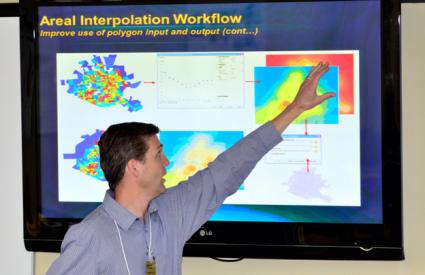
You better believe it. GIS certification might just give you an edge over other candidates. After they filter out hundreds of candidates, that GIS certification might be the tie-breaker you need.
But remember that GISP isn’t the only GIS certification game in town. In fact, Esri certification has been breaking a lot of ground. After all, it’s Esri software that is most used in workplaces, universities, and colleges.
Showing employers that you’re proficient in ArcGIS with an Esri certificate guarantees they are hiring someone with an advanced skill set. And let’s not forget all the free Esri training available to help you become proficient in your field of study.
There are online GIS certification options too from recognized universities. Because if you want to grow personally and professionally, you can’t just go with the flow. Instead, you need a direction to go in. So, GIS certification might just be the direction you need to go in.
READ MORE: GIS Certification: Is It Worth It?
If you’re looking to really complement your GIS skillset, then the emerging field of data science has some major benefits. Some of the top Nanodegree programs available related to GIS are below:
- Data Scientist
- SQL Database Administrator
- Data Engineer
- Python Programmer
- Machine Learning Engineer
- Data Visualization
10. Know the GIS Job Boards and Find Your GIS career
Scan the job boards and try to apply as soon as possible when new GIS jobs open. What are the boards with GIS job listings?
Because GIS is so diverse, there are so many career paths you can take. For example, you can work in cartography, programming, remote sensing, and even data science.
Don’t limit your job search keywords to just “GIS”. Instead, try to think outside the box. Here’s a list of GIS job search terms that usually go hand-in-hand.
Bonus: Try Thinking Outside the Box
Because GIS is an emerging field, some companies don’t know where or how to use it. Here are some non-GIS jobs where it still has some room to grow:
FIELD WORK: Heavy construction, forestry, environment, archaeology, and mining are industries begging for GIS. For example, you can set up GPS mobile apps in QGIS Field or ArcGIS Collector for any type of work. For example, they collect information on invasive species, endangered animals, and site excavations. Best of all, you get a mix of desk work and site visits.
SURVEYING: Surveyors go to construction to update legal boundary lines. No two days are the same for surveyors. Precise locations are taken for site exploration, land subdivisions, and civil engineering projects.
HIGH-LEVEL RESEARCH: As part of a master’s or Ph.D. program, you can get funded for high-level research. For example, you can write a research grant for a GIS-related hypothesis. Your university could point you in the right direction, test your hypothesis, and publish a paper.
DRONE PILOT: When Amazon conceptualized its mail-delivery drone, the GIS industry’s eyes lit up. Drones gather data from the sky in fields like agriculture, search & rescue, and the environment. Even realtors use drones to advertise open houses.
MILITARY OPERATIONS: The military is one of the biggest users of remote sensing and location intelligence. Ever since the Corona spy satellite, there’s been a growing demand for reconnaissance. But overseas deployment may not be in the cards for your life chapter.
Let’s Break It Down for You
Geographic Information Systems might just be the most “booming” career in terms of geography degrees.
If you’re studying geography, you need the right GIS career information.
Hopefully, these time-saving ideas help you pave the way to a bright future career in GIS.
Follow these 10 steps in this GIS career guide and instantly boost your chances of success.
Now, it’s your turn. What are some ways to help your chances of getting a GIS career?
Please let us know with a comment below.


